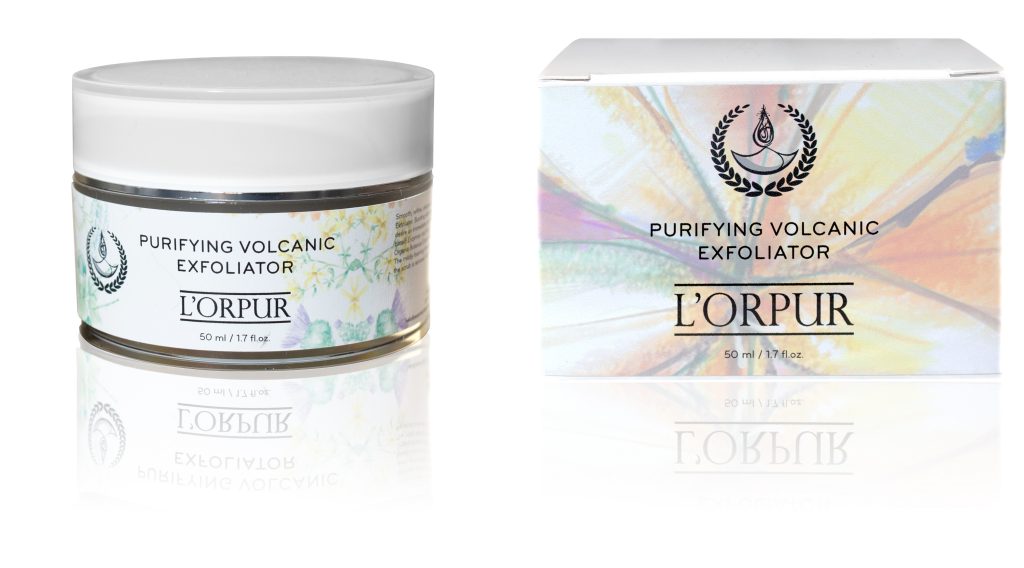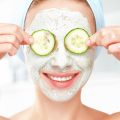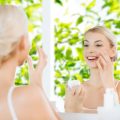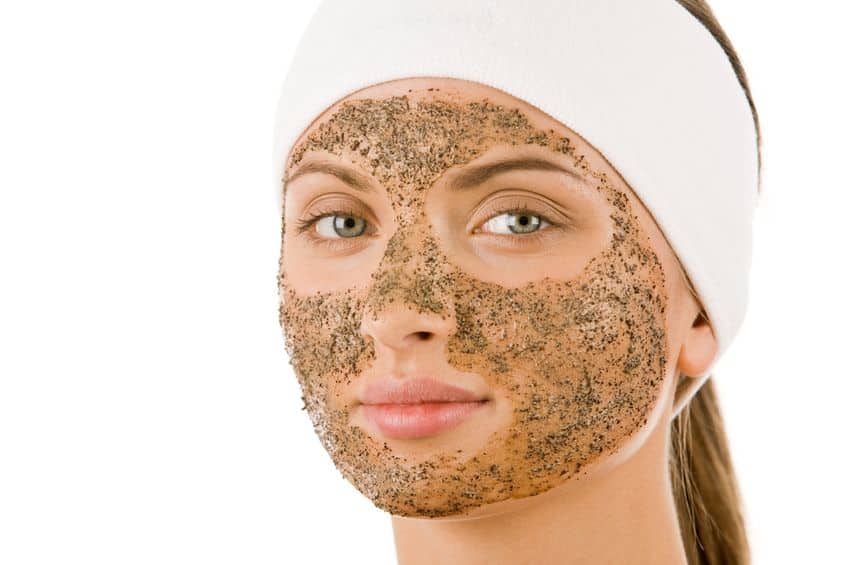
Exfoliating is a crucial step in the skincare process, as everything from clear glowing skin to rapid cellular regeneration is attributed to it. Yet, this treatment does not have an exclusive product dedicated to it and often gets clubbed with formulations meant to accomplish other tasks.
Simply put, exfoliation involves removing the dead skin cells that sit on the surface of the skin. When you are young, these cells get sloughed off naturally but with age, this is one of the physiological process that slows down, leading to a buildup of cellular debris.
These dead cells not only give you a lack luster complexion but also prevent skincare products from offering all their benefits because the active ingredients and nutrients often get fed to the dead cells and never make it to the new cells struggling to survive underneath.
Dealing With Those Dead Cells!
Exfoliation is certainly not a new entrant in the skincare arena. Women have long been using everything from plant seed and nut meal to sugar and salt to scrub away the dead cells. While this method still prevails, there are many other products available today. Generally, exfoliation can be clubbed into two categories:
Mechanical exfoliation
This is the actual act of scrubbing away the dead cells and there are a range of options available to get the job done. From the humble wash cloth to the new age sonic brushes and from smooth beads to microdermabrasion machines, you can find a myriad of products to rid your skin of dead cells that are ready to fall off.
Chemical exfoliation
While the scrubs and other gadgets help to slough off loose dead cells, chemical exfoliation helps to weaken the bonds that hold these dead cells together. Simply put, the acidic compounds used for chemical exfoliation melt the glue that make these dead cells stick to the surface of the skin. Goodbye dullness!
What Are Your Choices For Mechanical Exfoliation?
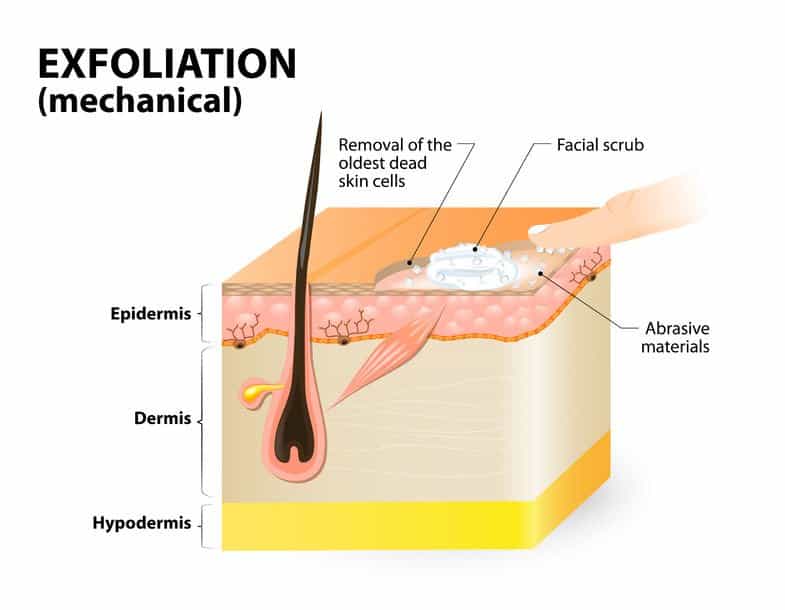
To say that there is a bewildering medley of mechanical exfoliation products available in the market would actually be an understatement. Here is a look at some of the choices, their pros and cons and how much you will have to shell out for them:
1. Exfoliating topical products
Either natural or artificial exfoliating beads (tiny plastic beads now banned in most countries) or botanical powders are made a part of a cleanser or mask, which is then rubbed on the skin to slough off dead cells. Jojoba beads and milled oil seeds are among the gentlest and safest options in this category, not to mention also environmentally friendly.
Salt and sugar are also often used as the exfoliators in these formulations. As far as botanical ingredients go, common options include citrus fruit peel powders, fruit pits, nut shells and herbal powder. These products are available OTC and work on most skin types as long as you don’t overdo the scrubbing.
Ideally, stay away from products that have nut shell and fruit pit powders because these can be too hard even on normally resilient skin. These formulations are available for $5 to $15, so they are among the cheapest exfoliating products in the market.
2. The humble wash cloth
Works just like the pit and shell powders but is gentler on the skin and you don’t risk micro tears. But, there is always the propensity to rub too hard and chaff the skin, causing inflammation. Because a washcloth does not seem to be rough enough, we tend to use a heavy hand.
Also, a washcloth can only target the loosest of dead cells. In terms of price, it cost nothing since most us already have a washcloth. But, it imperative to remember that you need to use a clean washcloth for the job or you risk an infection.
3. Exfoliating brushes
These are just regular soft bristle, nylon brushes that are used along with a cleanser for deep cleansing and exfoliation. You can buy them in mechanized as well as non-mechanized versions. The latter has a small motor that rotates the brush head, creating an abrasive effect that when used with your regular cleanser will remove makeup, grime as well as dead cells from the surface of the skin.
These brush heads either rotate or vibrate; the movement helps to buff away the dead cells. You also get exfoliating/deep cleansing brushes which come with bristle-free scrub pads or heads. These pads are abrasive to touch and use the same process for ridding the skin of dead cells.
A manual exfoliating brush will seldom cost more than a few dollars while a mechanized product will set you back by $20 to $50. Although a lot of users swear by just how effective these products are, bristle brushes and buff pads can cause redness and inflammation if you overdo the cleansing part. Also, they don’t always work on people with sensitive skin.
4. Sonic brushes
Clarisonic is the poster child for these types of brushes. The technology is the same as that used in sonic toothbrushes, you get a bristle head that vibrates/oscillates at a sonic frequency instead of rotating. The rapid, micro movements help to slough off skin cells without too much scrubbing and rubbing, resulting in less inflammation.
Sonic exfoliating/cleansing gadgets are available from a range of companies and cost between $50 and $250. Some of these use bristle brushes while others offer exfoliating pads. They can be used on wet or dry skin, although using them with a cleanser is the best way to deep cleanse.
Like regular exfoliating brushes, redness and inflammation are risks that you have to contend with when using these products. Of course, there is a whole army of women out there who zealously praise their Clarisonics but the fact is that these brushes, just like all others, don’t always suit those with sensitive skin.
5. Microdermabrasion
Although considered a salon treatment, you can find home units for microdermabrasion that work just as well and offer the same unparalleled results. The idea is simple, you will use an exfoliating head that is coated in diamond micro particles to scrub away the dead cells. The microdermabrasion head is attached to a wand that has a suction feature. So, you scrub off the dead cells and the dirt, while the vacuum like effect of the wand sucks up the excess oil, grime and cellular debris.
Microdermabrasion has its own legion of fans who vouch by its efficacy although it has not been scientifically proven that microdermabrasion is more effective than regular scrubbing. You may have already guessed that this is among the most highend exfoliation treatment and a home microdermabrasion unit will cost you between $200 and $500. Plus, you will need to replace the microdermabrasion heads from time to time and this is not an everyday treatment.
6. Natural sponges
These are soft scrubs made from natural products, either woven or unwoven depending on the raw material used. They are to be used just like you would a wash cloth. You simply work your skin over in circular moves with the sponge to scrub away the dead cells.
Although more expensive than a good ol’ washcloth, they carry the same risks as those involved in using the latter. However, because they absorb water/moisture and become quite soft, they work well on very sensitive skin. But, you have to be very diligent about keeping these sponges clean or you do risk an infection.
How Is Chemical Exfoliation Done?
Either an acidic substance or a fruit enzyme is mixed with a cleanser, mask, serum, moisturizer or a peel for chemical exfoliation. As far as acids go, the favored choices include:
Alpha hydroxy acids (AHA)
These are water soluble acids like lactic and glycolic acid, which dissolve the glue that holds the dead cells close to the surface of the skin, thus enhancing the natural shedding process. This not only gives the skin a more even and luminous look but also aids in improving the rate of cellular regeneration and enhances the absorption of skincare products. Moreover, chemical exfoliators help to deal with hyper pigmentation and wrinkles. All fruit acids like citric, malic and tartaric are a part of this class of compounds.
Beta hydroxy acids (BHA)
These are oil soluble acids that penetrate deeper into the dermal layers and impact the activity of the sebaceous glands. Salicylic acid is the most popular ingredient in this class. BHA’s are exceptionally effective against blemishes and offer deeper pore cleansing than AHA’s.
Fruit enzymes
You may also find ingredients like bromelain (a derivative of pineapple) and papain (extracted from papayas) in chemical exfoliators. These substances impact the dermal chemistry in the same way as the hydroxy acids. Depending on the concentration of these ingredients, their effect can often be stronger than that of the acids. So, these exfoliating enzymes are not generally recommended for sensitive skin.
Choosing The Best Chemical Exfoliating Product!
Cleansers
Among all comparable products, exfoliating cleansers are the gentlest. So, it takes a few weeks to see the results with these products, but they can be coupled with light mechanical exfoliators and the risk of inflammation is fairly low.
Serums and moisturizers
These are next in line and work quite well if used as instructed but they are stronger than cleansers and will be on the skin for a longer period of time. This means that there is a heightened risk of redness and inflammation.
Chemical peels
They are the strongest products in this category and cause significant amount of redness and peeling. In fact, a lot of these heavy hitters should only be used in a clinical setting and under the watchful eyes of a dermatologist. Even the hosed down versions available for home use penetrate deep into the dermal layers and boast of major exfoliating power.
Hence, it is very easy to go overboard with these products and cause chemical burns. So, you need to be absolutely sure about what you are doing before using these formulations. Chemical peels are not meant for those with sensitive skin.
What Type Of Exfoliation Will Work For Your Skin?
Oily skin
It is mistakenly considered to be the most resilient skin type to exfoliating efforts, which often leads to over exfoliation. And that is where people go wrong! Particularly, if you have acne prone, oily skin, you do not want to scrub those pimples and pustules too hard.
The idea here is to balance the sebum production and gently remove the cellular debris that blocks the pores and creates trouble. So for acne prone skin, a combined BHA and AHA cleanser works well. While mechanical exfoliators will not provide the desired outcome on indented skin, chemical exfoliators offer uniform results.
For oily skin without significant acne issues, combine a light chemical exfoliator like a BHA cleanser, serum or moisturizer with light mechanical exfoliation for best results. Ideally, use a product with low grade scrubbing power, like a soft nylon brush or jojoba beads.
Normal Skin
Because excess oiliness or dryness are not a problem for this skin type, all you need for normal skin is a bit of light scrubbing with a topical product. A cleanser with jojoba beads would offer fantastic results, as would a sonic cleansing brush/wash cloth. If you are battling hyper pigmentation, you may want to consider using a serum with fruit acids along with the other products.
Dry Skin
Since itchiness and flaking are both issues, dry skin benefits the most from sloughing off dead cells. Regular physical exfoliation using either a topical product or a device helps greatly to keep cellular debris in check. In fact, you can amp up the scrubbing power for this skin type. Moreover, flaking can be stopped in its tracks with mild chemical exfoliation. Once again, a light cleanser with a fruit acid that also provides some amount of moisturization will help the most.
Sensitive Skin
The use of chemical exfoliation and brushes is out of the question since both will trigger irritation and redness. If you have a medical condition that has led to extreme skin thinness and sensitivity, it would be best to stay away from exfoliation. If skin sensitivity is a genetic issue, use natural sponges for exfoliation as they are the gentlest.
Mature skin
This type of skin can be both dry and sensitive, yet it needs all the help it can get to boost cellular renewal and for that you will need to use both chemical and mechanical exfoliation. Your best bet in this case is regular microdermabrasion combined with light chemical peels that include both AHAs and BHAs.
How To Exfoliate?
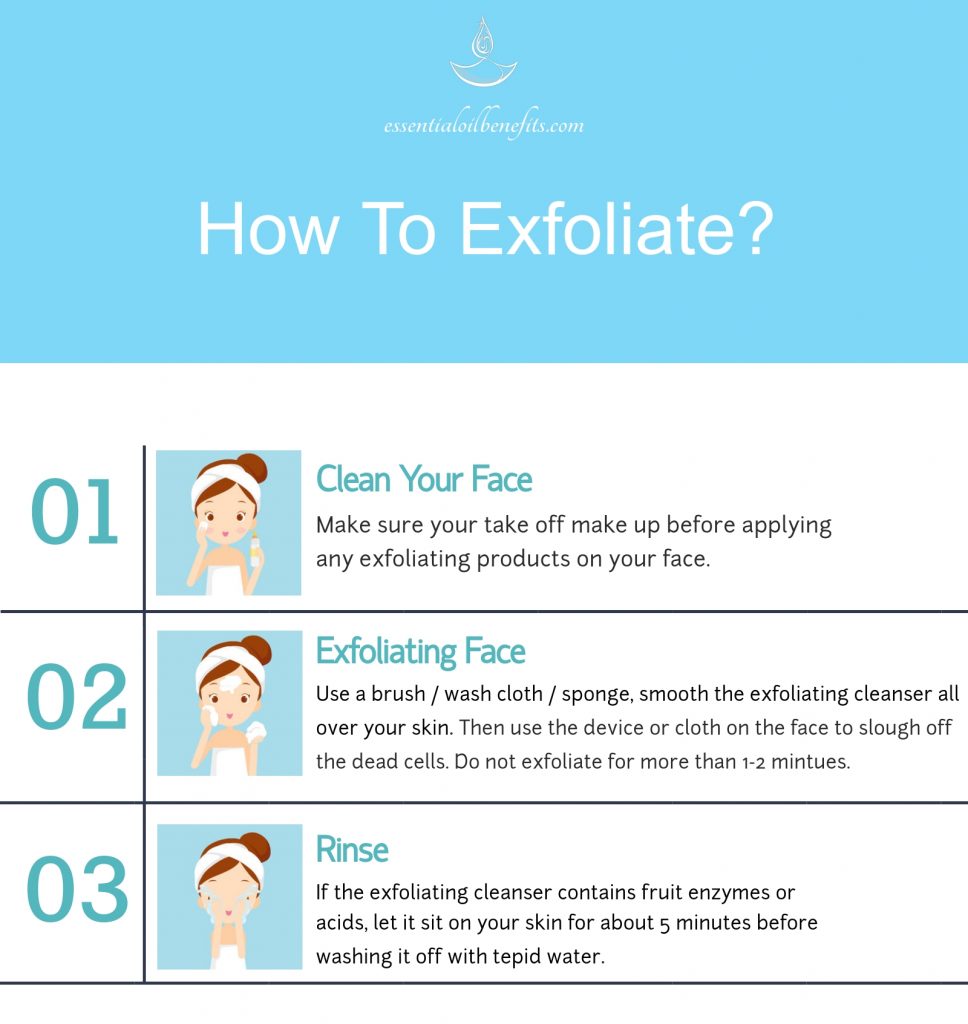
Step 1:
Even if you are using an exfoliating cleanser, make sure you take off your make up before applying the product on your face. The last thing you want to do is swirl and rub the day’s grime and dirt right back on your skin.
Step 2:
If using a brush/wash cloth/sponge, smooth the cleanser all over your skin and use the device or cloth on the face to slough off the dead cells. Do not exfoliate for more than 1-2 minutes.
Step 3:
Let the cleanser (if it contains fruit enzymes or acids) sit on your skin for about 5 minutes more before washing it off with tepid water.
15 Tips For Safe Exfoliation!
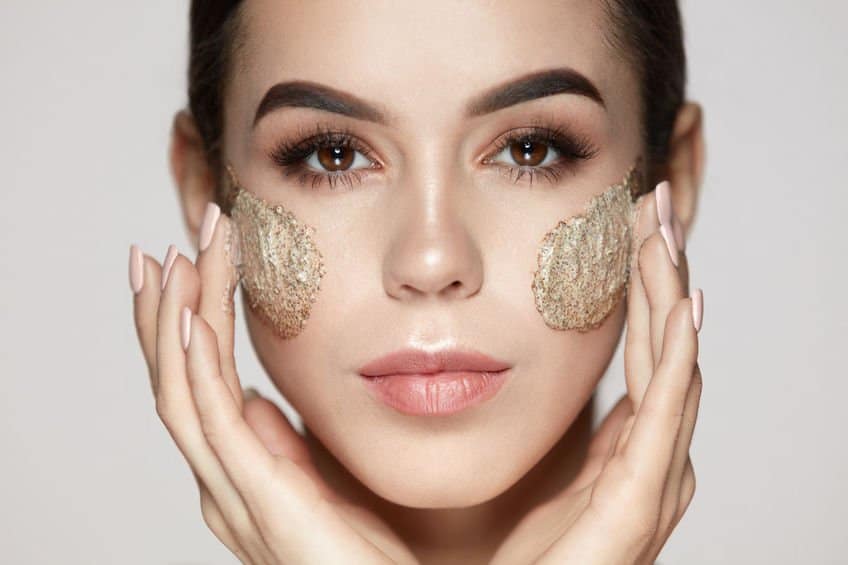
- Exfoliating at night helps if you are going to use a product with active ingredients like vitamin C, retinol or antioxidants after it.
- Regardless of your skin type, never exfoliate more than once a day.
- If you are going to exfoliate your skin every day, particularly if you are using a topical product with a fruit acid/enzyme, remember to replenish the natural oils that your skin is losing in the process.
- If you have over exfoliated, let your skin rest and recover for a week. Through this period, use a mild cleanser which does not contain drying ingredients.
- For exfoliation linked redness, use an OTC cortisone cream.
- Gentle buffing should be the aim when using a mechanical exfoliator. Remember, you are not trying to sand down your skin.
- Exfoliation should never be painful.
- For oily and acne prone skin, you can exfoliate daily while dry, normal and combination skin needs exfoliation only once or twice a week. For sensitive skin, stick to a routine of weekly exfoliation.
- If your skin flaking is intense and you skin is super dehydrated, replenish the moisture first and then consider exfoliation.
- Even when exfoliating in the morning, cleanse first and then exfoliate.
- Gritty formulations with coarse particles are only suitable for oily skin that has large pores and is prone to blackheads.
- Chemical exfoliation with a strong product is often more irritating to the skin than mechanical exfoliation.
- Your skin will be more vulnerable to sun damage after exfoliation, particularly chemical exfoliation, so always wear a sunscreen during the day.
- Retinol also stimulates exfoliation. So, you will experience some amount of peeling after using products that contain Vitamin A derivatives. It is best to stay away from chemical exfoliators while you are using these and instead use gentle mechanical exfoliation or take a day off from the retinoid for chemical/mechanical exfoliation.
- Always use a replenishing serum and moisturizer after exfoliation. The moisturizer is an absolute must but stick to a formula that does not contain retinoid, vitamin C or any other acidic compound. Oils, peptides, ceramides, antioxidants are all great after exfoliation.
Recommended Natural Exfoliator
The all-natural L’orpur “Purifying Volcanic Exfoliator” contains volcanic ash, organic oils (kukui nut oil, etc. ) and herbal extracts specifically developed for all skin types except for very sensitive / rosacea / psoriasis. Click here to read more information about the natural exfoliator.

